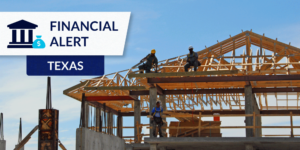
Citing $1,071,676.07 owed to multiple creditors — several local suppliers and contractors — Texas contractor TRS Construction, Inc. filed for Chapter 7 bankruptcy on October 4, 2021.
TRS Construction plans to liquidate its assets in order to pay back its debt, yet bankruptcy filings list just three vehicles, two computers, and a cashier’s check on its books —- a total estimated value of only $13,128.66.
According to the bankruptcy filing, TRS owes $263,652.72 to Alamo Concrete, $76,463.16 to B&B Plumbing, $65,621.83 to Overhead Door Corporation, $16,031.41 to Texas State Rentals, and $73,606.21 to Zen Construction, LLC, among others.
With another $1,058,547.88 in liabilities to make up for, TRS Construction’s bankruptcy may raise alarms for construction professionals across the country: Construction business failure rates are among the highest of any industry, with just 39% of new businesses surviving ten years and four out of five failing within 15 years.
High failure rates pose major risks to contractors and subcontractors and can have a domino-like effect across the payment chain. Professionals must be constantly aware of red flags that might indicate cash flow problems when dealing with other businesses, and may frequently worry about avoiding similar situations with their own customers.
Learn more: How the Payment Chain Works in Construction (And Why it Matters)
Legal actions have plagued TRS Construction in recent years
TRS Construction was named in two lawsuits in the past year alone. Alamo Concrete, a concrete contractor in San Antonio, sued TRS Construction over nonpayment of more than $260,000. Similarly, the company was also sued by Sprint Sand & Clay, a construction material provider based in Houston, for more than $3,000.
Various liens have also been filed against TRS Construction for nonpayment issues.
KAB Excavation was hired for “dirt work” by TRS Construction for a project in Fort Worth, Texas. Despite dealing with slow payments, KAB Excavation said they were surprised when they heard of TRS Construction’s bankruptcy filings.
“They were a little slow to pay at times, but we didn’t think too much of it,” a representative from KAB Excavation explained. “They finally told us there may be further delays due to COVID, but assured us that our final bill would eventually be paid.”
KAB Excavation was ultimately forced to file a mechanics lien against TRS Construction as the prime contractor for $4,659.70 due to non-payment.
Other businesses have experienced similar issues with TRS Construction. Ricardo Garcia, credit supervisor for Miner, Ltd., a facilities maintenance company with locations across the country, also filed a lien for $42,271.61 that named TRS Construction. Miner Ltd. never received payment for labor and materials provided for the “Express Oil Change” construction project.
Allied Fire Protection also filed a lien last year against TRS Construction for $14,625.50 after not receiving payment for installing a fire sprinkler system.
At the time of reporting, representatives from Alamo Concrete, Sprint Sand & Clay, Miner, Ltd., and Allied Fire Protection could not be reached for comment.
Contractors should look for payment warning signs
According to Levelset’s 2021 Construction Cash Flow & Payment Report, just 9% of a sample of contractors report always being paid on time, and only 11% report being paid in full on every job.
Yet most professionals accept this as the norm. According to Levelset’s 2020 National Construction Payment Report, 53% of a sample of contractors said they’re happy with how quickly they’re paid. As demonstrated by KAB Excavation’s dealings with TRS Construction, slow payment itself is not an immediate red flag.
However, the fact that it takes, on average, 83 days for construction businesses to be paid is a real concern for a company’s cash flow, and can be a leading cause for failure.
With upfront deposits becoming increasingly rare, a business must be comfortable operating with large outlays on its books for close to three months before seeing payment. Even then, payment in full might not be guaranteed.
Despite most professionals being somewhat accustomed to the construction industry’s long-standing payment struggles, uncontrollable factors can quickly spell trouble for businesses with stretched cash flows. The effects of the COVID-19 pandemic, for instance, could certainly have exacerbated existing cash-flow problems and contributed to increased financial problems for TRS Construction.
TRS Construction’s bankruptcy should serve as a warning sign to construction professionals everywhere. TRS Construction’s inability to pay back most of its debt will likely result in their many contractors experiencing cash flow problems of their own, as well as further down the payment chain.
What started as a minor, unremarkable issue of slow payment quickly escalated to a Chapter 7 bankruptcy for TRS Construction. In order to minimize the risk of failure, construction professionals may be wise to make changes wherever possible to alleviate pressure on their cash flow.